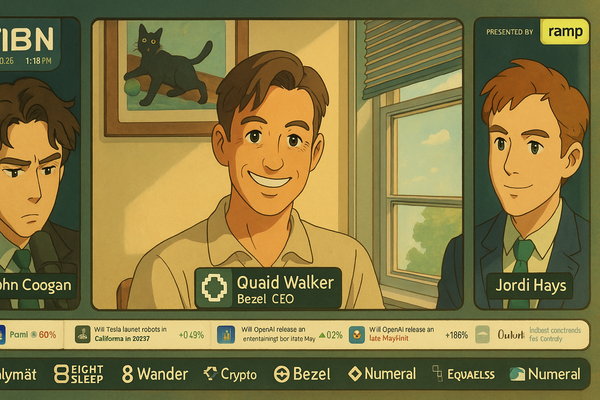Ownership
Navigating conflicts is tough in media
Thanks so much for feedback on Tuesday’s edition. I’m going to share some of it next week. Please send more by hitting reply or emailing me directly: bmorrissey@therebooting.com.
On that note, I would love to meet all of you… in Chicago. Omeda, the full-stack marketing technology platform for managing first-party data, has been a great supporter of The Rebooting. Each year, Omeda holds a three-day industry summit called OX6 that brings together media industry professionals in downtown Chicago, which happens to be one of my favorite cities, particularly when it’s not winter. I’m going to be speaking there, and I hope you’ll consider joining. The event is from May 10-12. Right now, Omeda is offering early-bird registrations for OX6 for a mere $395. And if you come, I’ll buy you a beer.

Ownership
Semafor turned three months old yesterday. Considering the nearly yearlong striptease prior to its launch in October, you could be forgiven for thinking it had been with us longer. On the same day, the company told The New York Times it would bow to the inevitable and return the investment disgraced crypto boy king Sam Bankman-Fried plowed into the company.
Semafor had dismissed the backing, saying it wasn’t critical, although it turned out that SBF has been the biggest backer of the company, putting in $10 million of the $25 million in financing used to launch Semafor, which has 60 employees. That’s a big hole to fill in 2023 vs the still-frothy days of 2022 when Semafor raised.
It also highlights how fraught ownership is for media businesses, which depend on trust. Every business needs capital. It’s the oxygen of business. You can either get capital from other people or generate it through your operations. No matter the form of equity or warrants or if you use a SAFE note, sharing ownership with third parties can be dicey business, no matter the safeguards put in place.
Why SBF backed Semafor, and tried to recruit prominent writers like Matt Ygelsias to a new publication, remains a mystery. Rich people often do rich people things, and media has always been an entree to influence and access to power. There’s a reason Jeff Bezos bought The Washington Post, and I’m sorry to say it isn’t just to pry democracy from darkness.
A media business is about navigating conflicts — or tensions, if you want to use a euphemism. You have conflicts between what is best for your audience and what your advertisers want. You can see that tension at play in visiting just about any local news site and enduring an assault on your senses with all manner of autoplay video and massive ads blocking articles. Conflict is often embedded inside business models. That conflict invariably manifests itself in adversarial approaches to the audience that publishers wouldn’t exist without.
In the news business, the appearance of conflict is enough to dent credibility. I like to play hunt-the-disclosure in Semafor stories about FTX’s collapse and the SBF saga. In truth, I can’t say to me the publication has pulled any punches. I’ve found its coverage, particularly Liz Hoffman’s, to be informative and rigorous, hardly cozying up to a disreputable figure who is accused of stealing a whole lot of money and using it on a whole bunch of things, including funding Semafor. The basic fact is, as it stands, Semafor wouldn’t exist without SBF’s money.
That’s a problem. And it’s one that is on some level simply the risk you take with taking funding, or to me giving up ownership. Taking on backers adds a level of conflict to any business model. Elon Musk could dismiss Semafor’s coverage of him by calling the company “employees of SBF” and saying it is “owned by SBF” with a “massive conflict of interest.”
For journalists, this is a raw deal. They don’t have the say in who owns the company where they work. The crypto guys can dismiss the “corrupt corporate media,” and spin far-fetched conspiracy theories involving “the Sulzbergers” in league with a global elite to undermine tech companies that are freeing the masses from the yoke of oppression. Like all humans, the journalists I know are flawed, although I could think of no worse group of people to try to rope into a well-oiled scheme.
Crypto is the home of no conflict, no interest, and many messy ownership structures. Several crypto media companies are entangled with the industry they cover. The Block’s ownership status is in disarray after its CEO and majority owner disclosed personal loans from Sam Bankman-Fried. The company is apparently looking for a way to wrest ownership from Mike McCaffrey. Coindesk is also hanging up the for-sale sign as its owner, Digital Currency Group, is caught up in the ongoing crypto meltdown and is the subject of investigation. Decrypt has raised $10 million to become independent from Consensys Mesh, an outfit owned by a crypto entrepreneur. Whether Web3 solves this is an open question.
Ownership conflicts will become even more awkward as companies back their own forms of media directly. Robinhood is spinning out out its media assets as an independent subsidiary and bringing in former Verge and Bloomberg exec Josh Topolsky to run the media entity. The timing of the move is interesting. Usually tech companies get media ambitions during flush times. Robinhood, like its peers, has seen its stock get crushed in the past year, down 50%. Josh compares it to Bloomberg owning a news arm. We’ll see.
There’s no purity test in the media business. You manage conflicts and disclose them. I can remember when Pando Daily launched with several big-name Silicon Valley backers, it was regularly lampooned for its extensive article disclosures since its subjects were often backers. Awkward. The same can be said of Grid News, which has a bunch of ties to the UAE. The reality is even if there aren’t clear individual ties, publisher ownership structures have conflicts that will be seized on by good-and bad-faith critics of their coverage.
One of the reasons I’m optimistic about the future of publishing is the opportunity to build smaller but more autonomous publishers that have fewer of these ownership issues. The need for capital to build larger companies requires compromises in autonomy by giving up ownership to others who, let’s face it, tend to have interests that go beyond financial returns. I’m no financier, but I can think of better ways to put money to use than to invest in publishing companies. And that autonomy enabled by ownership will engender greater trust from the audience in navigating inevitable conflicts. It’s easier to see nefarious motives in faceless entities than it is in people you know, or feel like you know.
Bootstrapping will become more common in a time of less capital. That’s overall a good thing. Building from scratch is hard, and doing it from cash flow is harder, but it enforces discipline in doing more with less and having relentless focus. Bootstrapped companies are far less likely to pivot to video. It also gives you autonomy and true independence. There will still be conflicts in media business models, of course. You can’t have ads in your business model without introducing a form of conflict, no matter what walls you want to put up. You can’t have an events business without needing to get top executives as keynote speakers. If you’re a non-profit model, you are dependent on funders. Affiliate models turn a publisher into Ron Popeil. And so on.
Ownership remains the best path to autonomy. The tell that the sharing economy was bullshit was that those those hyping it owned their homes and cars. One of the attractions of newsletter and podcasts becoming media businesses of their own right is the “creator,” to use a term I hate, has ownership. The need for massive infrastructure and access to costly distribution channels made that impossible previously. The people with the capital called the shots, and I think in most cases the media products suffered. Lots of things look great on spreadsheets that the people who make the product know are a terrible long term idea. You can make the best arguments in the world, the people with ownership are the ones who call the shots.

House of Kaizen acts as an extension of subscription revenue growth teams. One of the things that keeps coming up in my conversations is a focus on churn. I asked Matt Cronin, founding partner, about what he’s seeing across House of Kaizen, if we’ll see publishers move from a growth-at-all-costs approach to focusing more on keeping existing customers happy, engaged and finding value.
“I hope retention or churn mitigation gets the attention it deserves. Net growth businesses can’t survive on acquisitions alone, particularly when the acquisition strategy is all about lowest possible CPA and counts of subscribers, rather than aiming for the acquisitions that are most likely to produce sustainable CLV with low likelihood to churn out. This is what makes a subscription business better, after all, so if this is the year more focus and resources are applied to a balanced growth strategy, I’m looking forward to it.”

Recommendations
While I don’t like to do predictions, one I’d make is Substack makes a move to become something of a Twitter alternative. As a publisher, I would prefer it just focus on improving analytics and providing basic audience segmentation tools and being a better email service provider. But there’s an opening to become a consumer platform. Substack is rolling out what it’s calling “private Substacks” for people to gather communities of interest. One of the interesting developments to track is whether the tie between Twitter and Substack becomes frayed, as Packy McCormick’s experience hints. Personally, I’ve never gone down the path of using Twitter to promote this newsletter. Threads are too humiliating.
A macro trend for the year is a shift of focus from growth to sustainability. In subscriptions, that means moving from a focus on filling the top of the funnel with new subscribers, often at steep discounts, to keeping those subscribers on board by providing value. Jack Marshall has thoughts from several leaders of subscriptions at publishers, and that was a theme that stuck out for me. One publishing exec I spoke to this week lamented the two-front battle Getting people in (acquisition) and keeping them in (mitigating churn).
On that note, Zephr has created an e-guide to help digital publishers reduce their subscriber churn. Download “Keep customers for life: The digital publishers handbook for reducing customer churn” today and discover tips and best practice examples on how to retain your subscribers. (Sponsored)

Thanks for reading. Hit reply with feedback and please share The Rebooting with anyone you think would find it valuable.
I’ve been fortunate to work with some great partners as sponsors of The Rebooting. What I’m trying to do with sponsorships is make them additive to the product instead of the adversarial tactics. Get in touch if you’d like to talk about working together: bmorrissey@therebooting.com.




